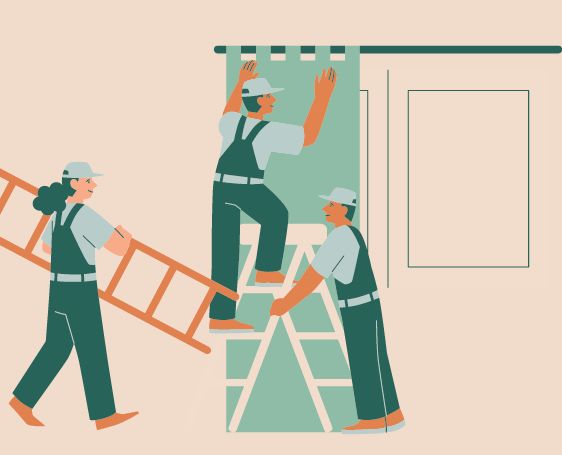While metal ladders themselves are not an immediate solution to reducing the effects of climate change, they can play a role in various ways to support sustainable practices and climate change mitigation efforts. Here are a few examples:

- Facilitating renewable energy installations: Metal ladders can be used to install and maintain renewable energy sources, such as solar panels and wind turbines. By enabling workers to access these structures, metal ladders can help promote the widespread adoption of clean energy.
- Green construction and building retrofits: Metal ladders are essential tools for workers involved in green construction projects and retrofitting existing buildings to improve energy efficiency. Using ladders in these projects helps to reduce energy consumption and greenhouse gas emissions.
- Urban greening: Metal ladders can support urban greening projects, such as installing green roofs and vertical gardens. These projects help to improve air quality, reduce urban heat island effects, and increase overall carbon sequestration in urban environments.
- Recycling and repurposing: Metal ladders made from recycled materials, such as aluminum or steel, contribute to a circular economy by reducing the need for raw materials and energy consumption during production. Additionally, old or damaged metal ladders can be recycled and repurposed, further minimizing waste.
- Tree planting and maintenance: Metal ladders can be used to access and maintain trees in urban and rural environments. Tree planting is crucial to climate change mitigation, as trees absorb carbon dioxide and provide numerous ecosystem services.
- Research and monitoring: Climate change researchers may use metal ladders to access hard-to-reach locations, such as weather stations or remote sensors, to collect data on climate change and its environmental effects.
While metal ladders do not directly reduce the effects of climate change, they can support various activities and initiatives that contribute to climate change mitigation and adaptation efforts.

Ladders in the Workplace
Ladders are a common and essential tool in many workplaces, but they can pose significant risks if not used properly. Following ladder-safe work practices is crucial to ensure the safety of employees and prevent accidents. This article provides a detailed overview of essential ladder safety tips for the workplace.
- Choosing the Right Ladder – Selecting the proper ladder length for the task is vital for safety. Using an inappropriate ladder can lead to instability and accidents. Always choose a ladder that is designed for the specific job you’re performing.
- Ensuring Stable and Level Surfaces – Workers should use ladders only on stable, level surfaces. Secure the ladder to prevent movement, or use slip-resistant feet if the ground is uneven or slippery. Only use ladders on wet concrete floors or muddy ground with proper precautions.
- Ladder Placement – Place ladders away from locations where they can be bumped or displaced by workplace activities, such as passageways, doorways, or driveways — you can use a ramp for handicapped for these structures. Secure the ladder or barricade the area to prevent accidents. Keep the access area around the ladder’s top and bottom clear of debris and materials.
- Accessing Upper Landing Surfaces – When using a ladder to access an upper landing surface, ensure the ladder rails extend at least three feet above the upper landing to provide proper handholds with the correct height for handrails.
- Ladder Maintenance – Like your usual metal stairs, ladders must be clean and free from oil, grease, mud, and other slippery substances. Regularly inspect ladders for damage and ensure they are not overloaded beyond their maximum intended load or the manufacturer’s rated capacity.
- Proper Ladder Usage – Use ladders only for their intended purpose and follow the manufacturer’s instructions. Do not use ladders as walk boards, platforms, or for other unintended uses.
- Climbing Safely – Always face the ladder when climbing and maintain three points of contact. Keep your hands free for mounting, and avoid carrying tools and materials. Use a rope and bucket, or have someone assist you with tools and materials.
- Stepladder Precautions – Avoid standing on the top two rungs of a stepladder, as this can decrease stability. If you need to reach higher, arrange for a taller or longer ladder before work begins.
- Electrical Safety – Never use metal ladders near electrical equipment. Opt for fiberglass ladders, which are designed to protect against electrical hazards.
- Ladder Alterations and Adjustments – Do not alter or splice ladders in any way. When adjusting a ladder, always climb down first, make the necessary adjustments, and then climb back up.
- Extension Ladder Angle – Place extension ladders at the proper angle using a 4:1 ratio (approximately 75 degrees). For every four feet in height, move the ladder base one foot away from the wall or structure.
Ladder safety is crucial to maintaining a safe working environment. By following these ladder-safe work practices, employees can minimize the risk of accidents and ensure their well-being. Always prioritize safety when using ladders and make it a habit to follow these guidelines in the workplace.
Metal ladders can serve as valuable tools that support a wide range of climate change mitigation and adaptation efforts. By facilitating the installation and maintenance of renewable energy sources, promoting green construction and building retrofits, aiding urban greening projects, encouraging recycling and repurposing, assisting in tree planting and care, and enabling climate research and monitoring, metal ladders indirectly contribute to reducing the effects of climate change. Though not a direct solution, their utility in these various applications underscores the importance of considering how everyday tools can play a part in addressing this global challenge.
